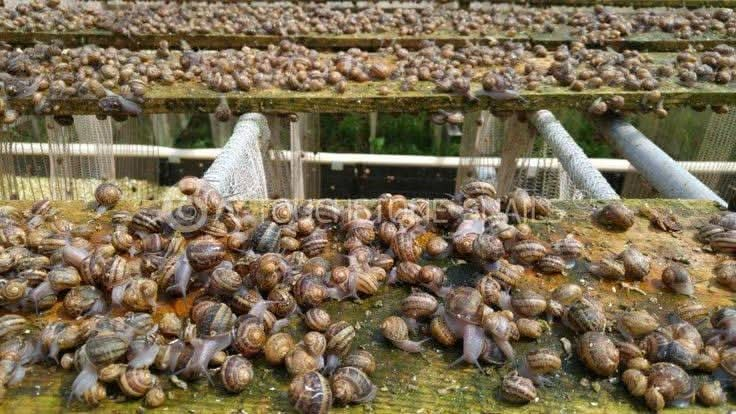Snail Farming and Its Business Potential in Nigeria
Snail Farming and Its Business Potential in Nigeria
Snail farming, also known as heliciculture, is a growing agricultural venture that has gained popularity due to its profitability, low setup cost, and rising demand for snail meat and snail byproducts. As people become more health-conscious, snail meat has seen an increase in demand due to its high nutritional value, being rich in protein, low in fat, and abundant in essential amino acids, iron, calcium, and magnesium. Here’s a deep dive into the factors that make snail farming a lucrative and sustainable business.
1. Understanding Snail Farming
Species Selection: Not all snails are suitable for farming. The most commercially viable species are Archachatina marginata, Achatina achatina, and Achatina fulica, commonly found in West Africa. These species are large, reproduce quickly, and adapt well to various farming environments.
Breeding: Snails are hermaphrodites, meaning each one has both male and female reproductive organs, allowing them to reproduce prolifically. Snails can lay hundreds of eggs annually, leading to rapid population growth if managed properly.
2. Setting Up a Snail Farm
Environment: Snails thrive in humid, cool environments. They require a moisture level of around 75-95% and temperatures between 20-28°C. Shaded, well-drained soil is essential to keep them comfortable and to ensure healthy growth.
Housing Options:
Free-range pens: Simulate a natural habitat, allowing snails to move freely in an enclosed garden-like space.
Trenches or containers: These are typically used in more intensive farming setups.
Feeding: Snails are herbivores and eat various leaves, fruits, and vegetables. They especially enjoy leafy greens like lettuce and cabbage, as well as fruits like pawpaw and bananas. Providing a calcium-rich diet (e.g., crushed eggshells or bones) is also essential for shell development.
3. Investment and Costs
Initial Costs: Starting a small snail farm requires minimal investment compared to other livestock ventures. Basic costs include snail pens, feed, and breeding stock.
Recurring Costs: Food and labor are the main recurring costs. However, snails are low-maintenance animals, making ongoing expenses manageable.
4. Profit Potential and Market Opportunities
Local and Export Markets: There is a strong demand for snail meat in local markets across Africa. In addition, international markets, especially in Europe and Asia, are interested in snail products. Snails are typically sold fresh, frozen, or processed.
Byproducts: Beyond meat, snail slime has valuable medicinal and cosmetic applications due to its regenerative properties. It is used in skincare products for its ability to help with wound healing and skin rejuvenation, opening up another revenue stream for snail farmers.
Profit Margins: The profit margin in snail farming can be high, depending on the scale and efficiency of operations. A single mature snail can sell for a good price in local markets, and with adequate breeding, a farmer can significantly multiply their stock within a year.
5. Business Considerations
Market Research: Before starting, it’s essential to understand the demand for snail products in your area and potential competition.
Legal Requirements: Check local regulations regarding snail farming and export if planning to serve foreign markets.
Sustainability: Snail farming is environmentally friendly, as it requires low resources and contributes little to pollution. It’s also a great way to improve food security by providing a high-protein, low-cost meat source.
6. Challenges in Snail Farming
Climate Control: Snails are sensitive to temperature and moisture changes, so maintaining a consistent environment is crucial.
Predators and Pests: Birds, rats, and certain insects can threaten snails, so farms need to be secure.
Diseases: Though snails are hardy, they can sometimes be prone to fungal infections, particularly in overly damp conditions. Regular monitoring is necessary to prevent and manage diseases.
7. The Future of Snail Farming
Health and Wellness Market: With the rising interest in organic, nutrient-rich foods, snails provide a promising source of sustainable protein. The growth of health-conscious diets and the demand for collagen-rich products place snail farming in an excellent position to expand.
Expansion into Beauty and Pharma: Snail slime is increasingly used in anti-aging and skincare treatments, with demand for snail-based beauty products growing globally.
Conclusion
Snail farming offers an exciting and profitable business venture that requires minimal input and yields high returns. The demand for snails extends beyond meat to include cosmetic and pharmaceutical applications, making it a versatile business opportunity. For individuals looking to enter agriculture, especially on a small scale, snail farming presents a sustainable, low-risk, and potentially highly profitable enterprise. With proper management, attention to climate needs, and a focus on local and international markets, snail farming could become a significant contributor to both food security and economic empowerment.




